Red and green should never be seen, says…well, it seems perhaps no-one. It is one of those phrases that many of us have heard and yet the origins seem to be somewhat muddy. It might be purely about fashion; that it was considered the two colours just didn’t complement each other. But, it seems as many people know the phrase as blue and green, so down that road we can insert any colour as the one not to be seen with green. There is also a view that it refers to the lights on a ship, green on the starboard side and red on the port meaning that, if you can see these colours when out in your own boat, you may well be headed on a collision course.
But, as it always does, nature defies the rules (whatever they may be) and red and green are often seen – and very pleasingly so. I took a five-minute sit outside after work today. The weather wasn’t particularly pleasant but I find I desperately need at least a few minutes outside a day to feel (vaguely) human. Armed with a warm drink* I sat out by our small pond and noticed that the seasons were showing their turning. Tangled waterfalls of red 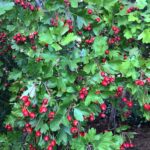 berries and green leaves are draping from the hawthorn trees. Towering
berries and green leaves are draping from the hawthorn trees. Towering
over my head and reaching almost down to the floor, they are like a vertical carpet of nature having a go at pointillism.
Behind me, a rose has gone to hip. I play the game, each year, of trying to balance the dead-heading of flowers to prolong the blooms coming out, but also leaving enough to turn to hips, because the 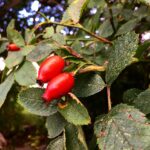 birds love them so. I have made rosehip tea in the past, collecting, cutting, scraping out the insides and drying the hips and it was tasty – but, a lot of not very pleasant work. The inside of a rosehip is filled with prickly, sticky hairs and they all have to be removed or will be an irritant when drinking. It takes a long time to prepare so many fiddly little hips and I know from experience that I don’t really have the patience.
birds love them so. I have made rosehip tea in the past, collecting, cutting, scraping out the insides and drying the hips and it was tasty – but, a lot of not very pleasant work. The inside of a rosehip is filled with prickly, sticky hairs and they all have to be removed or will be an irritant when drinking. It takes a long time to prepare so many fiddly little hips and I know from experience that I don’t really have the patience.
The honeysuckle flowers are all pretty much all gone now but the tiny, 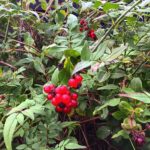 shiny red berries punctuate the long meandering tendrils. It doesn’t seem to matter how much or when I cut this particular honeysuckle back, it soon
shiny red berries punctuate the long meandering tendrils. It doesn’t seem to matter how much or when I cut this particular honeysuckle back, it soon
swamps everything around it. The weeping crab apple tree is also in fruit now -and occasionally cat. (Big cat is a climber and it is not unusual to look out of the window and see his head peeping out from the top of the tree.)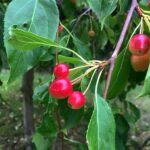
And there is more to come, the pyracantha (the spiny, spikey, flesh-ripping beast that it is) will keep the blackbirds in snacks all winter and of course, the holly will be ready to decorate the house at Christmas time.
But we also have a scattering of fairy wings in what I (optimistically) call our woodland area (the shady bit under mystery tree**). White and pink cyclamen gather in groups, standing small but proud from their round 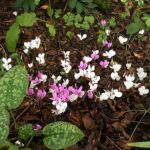 tubers. Cyclamen have their seed heads on tight coils which when ripe project the seed head and seeds onto the ground – the sticky seeds are then sometimes moved about by ants. Just imagine if you could capture the pinging and flinging of seeds by the release of tensed coils on film – I can’t help but visualise it in some sort of Acme cartoon cannon style with some dramatic full-orchestra music going on behind the whizzing and whirring.
tubers. Cyclamen have their seed heads on tight coils which when ripe project the seed head and seeds onto the ground – the sticky seeds are then sometimes moved about by ants. Just imagine if you could capture the pinging and flinging of seeds by the release of tensed coils on film – I can’t help but visualise it in some sort of Acme cartoon cannon style with some dramatic full-orchestra music going on behind the whizzing and whirring.
But this week hasn’t been just about flowers; pond life has had its show too. Poking about my mum’s garden, having a catch up on what has and hasn’t survived the ridiculous heat followed by winds and torrents of rain, we 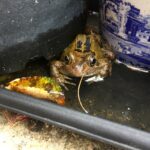 spotted a frog making use of the plant pot tray on her patio. It seemed quite happy and we think perhaps waiting for some of the dropped insect-based bird food from the feeders nearby. And we have a new resident, Gary. Gary is a snail who was doing the sterling job of keeping my niece’s fish tank clean. Alas, the fish are no more, which is timely actually,
spotted a frog making use of the plant pot tray on her patio. It seemed quite happy and we think perhaps waiting for some of the dropped insect-based bird food from the feeders nearby. And we have a new resident, Gary. Gary is a snail who was doing the sterling job of keeping my niece’s fish tank clean. Alas, the fish are no more, which is timely actually, 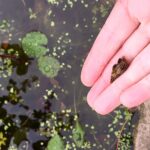 as niece is just about to head off to university. Needless to say, my sister was not about to keep a tank going in her daughter’s absence for just one snail, and so Gary was ferried over to our pond via a small tub with holes in and a fruit basket in the footwell of my car.
as niece is just about to head off to university. Needless to say, my sister was not about to keep a tank going in her daughter’s absence for just one snail, and so Gary was ferried over to our pond via a small tub with holes in and a fruit basket in the footwell of my car.
*If you’re interested; a mix of cacao powder, turmeric, ginger, cinnamon and star anise with hot water and unsweetened almond milk. Yes, yes I am ‘that’ person.
**We know it is a cotoneaster, but it was unidentified for so long, it will never be called anything but mystery tree in our house. *Whispers* it also has its own theme tune.
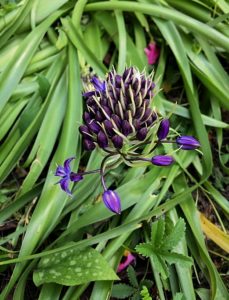 The best thing though, was that they told me that they called them angry panthers, and to this day, that is what I call them too. I know roughly where it is located but the ground covering mat of ajuga, pulmonaria and creeping cinquefoil, has hindered any precise pinpointing – hence the search. So far, the angry panther remains elusive, but I live in hope.
The best thing though, was that they told me that they called them angry panthers, and to this day, that is what I call them too. I know roughly where it is located but the ground covering mat of ajuga, pulmonaria and creeping cinquefoil, has hindered any precise pinpointing – hence the search. So far, the angry panther remains elusive, but I live in hope.